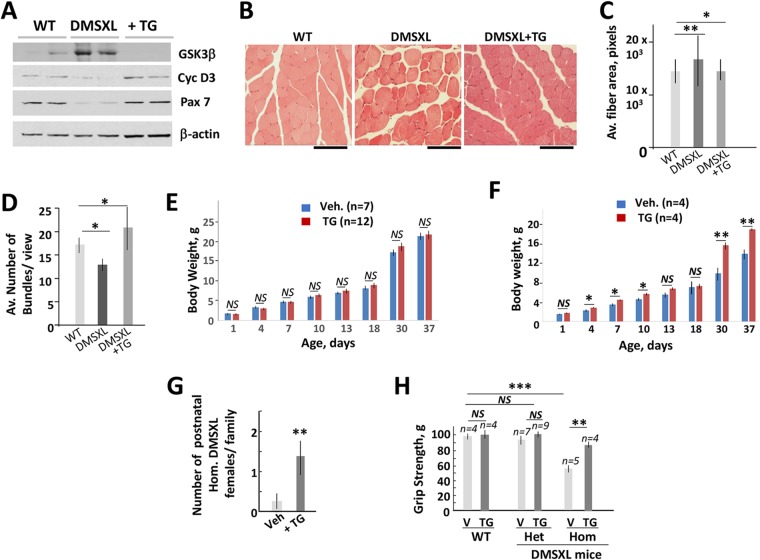FIG 6.
GSK3β-cyclin D3 pathway is abnormal in skeletal muscle of DMSXL mice. (A) Western blot analysis of protein extracts from diaphragm of the matched WT, untreated, and single-dose TG-treated (0.1 μg/g) 2.5-month-old het DMSXL mice (females) with antibodies to GSK3β and cyclin D3. The levels of a marker of muscle regeneration, Pax7, were also examined. β-Actin was a loading control. (B) HE staining of gastroc from the matched areas of the age- and gender-matched WT, untreated, and oral TG-treated (0.1 μg/g, two times a week) hom DMSXL mice is shown. Note myofiber size variability in gastroc of untreated DMSXL mice and the reduced fiber size variability in the treated DMSXL mice. The scale bar is 50 μm. (C) Normalization of fiber size in gastroc of the TG-treated 2-month-old hom DMSXL mice (0.1 μg/g, two times a week for 1 week). Two mice per group were analyzed. (D) Correction of GSK3β improves bundling in skeletal muscle of DMSXL mice. The number of bundles was counted at ×10 magnification for each mouse group (2 mice per group). (E and F) Comparison of the body weights of WT (E) and hom DMSXL mice (males) (F) produced by DMSXL females treated with the vehicle (2 times, 0.1 μg/g) (n = 5 [WT]; n = 5 [DMSXL]) or TG (n = 5 [WT]; n = 4 [DMSXL]) during gestation. Changes of the body weight in WT mice produced by the vehicle-treated versus TG-treated DMSXL females are not significant. (G) Average number of postnatal hom DMSXL mice (females) per family produced by the vehicle (n = 6)- or TG (n = 6)-treated DMSXL mice during gestation. (H) The grip strength is increased in hom DMSXL males produced by females treated with TG during gestation. The number of analyzed mice is shown at the top. *, P < 0.05; **, P < 0.01; ***, P < 0.001. NS, nonsignificant change.

